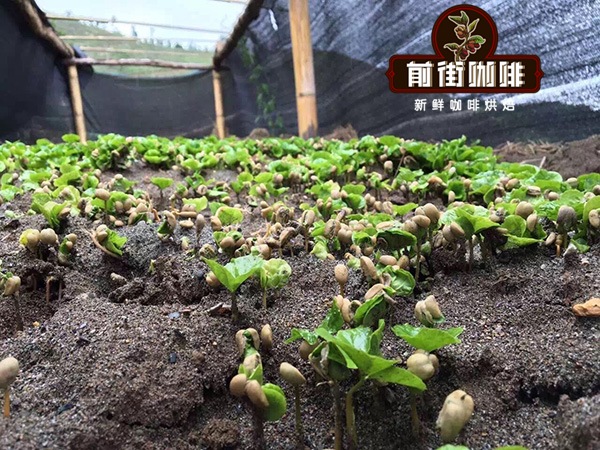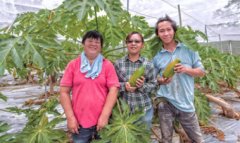Summary of breeding steps in Qianjie Coffee Plantation: seedling raising, planting and shading
Before coffee breeding, we should pay attention to the following situations:
1. In general, raw coffee beans do not have the conditions for germination, so it is possible to breed coffee seedlings and have a high survival rate by using fresh coffee fruits or shell beans with parchment paper. According to our experience, the newly picked coffee beans can basically guarantee 90% germination rate.
two。 To cultivate coffee seedlings, use clean river sand to ensure good drainage and moisturizing function, watering every three or four days. Because of the production environment, Qianjie coffee uses mountain sand.
3. The time of breeding, of course, here means that we should pay attention to the time of breeding when it is used in actual production. Using the inverse method, a moist environment of about half a year is needed after the coffee is planted, to ensure a good survival rate when the coffee producing area has only the dry season and rainy season, so it is necessary to know the time of the beginning of the local rainy season (in Southeast Asia, for example, the rainy season is from May to October), that is, when we planted it in May. Can have half a year Rain Water time, put forward a whole year, that is, February-May of the previous year is the best breeding time. By the time we plant it, we will have coffee seedlings for a year, and there will be enough slow seedlings after planting.

Nursery preparation:
The selection of nursery should pay attention to the shading effect. Seedlings exposed to direct sunlight are easy to die and reduce the survival rate. Therefore, the nursery must have shading equipment, shading materials can use shading nets, thatch or straw, or you can choose to form a nursery under rows of big trees to cultivate coffee seedlings. Secondly, drainage facilities should be done well. Poor drainage can easily cause seedlings to rot.
There are basically two ways of raising coffee trees: sowing on demand and cuttings.
After the coffee fruit is harvested, it is peeled and fresh seeds with gelatinous shape are selected for sowing. Spread the seeds directly on the seedbed containing sandy loam, and then cover a layer of thin soil about 1 cm thick, the soil should not be too deep, otherwise the seeds will not germinate easily. After sowing, water should be sprinkled regularly to maintain soil moisture. In the second way, the seeds are sown directly in a 3-inch seedling pot filled with sandy loam, one in each pot. Then cover a thin layer of soil about 1 cm thick. After finishing the sowing work, sprinkle water regularly and keep it moist.
Normally, it takes 45-60 days for seeds to germinate after sowing. When sprouting, you first stick out the growing root and straighten the coffee bean up to make it look like a soldier in a helmet. At this time, it is called Soldier. About two weeks later, a pair of cotyledons are sticking out, shaped like butterflies, which is now called Buterfly. About a month later, the first pair of true leaves will grow. After the seeds sown on the seedbed grow 2-4 pairs of true leaves, they can be transplanted into a 4-inch nursery pot.
After five to six months, the seedlings grow 4-8 pairs of leaves, which can be grafted. The grafted plants can adapt to the environment and enhance disease resistance. However, it is not usually adopted.
Another method of propagation is cutting, but this method has not been used in Taiwan. Choose the annual side branches of the mature coffee tree, not too close to the trunk branches, not too thick. Cut into segments every 10 cm, each with a pair of leaves. Each section is cut in half longitudinally, and each section has a leaf. Cut off some of the leaves left on each branch. Insert the branches with leaves upward into the seedbed or in a pre-prepared seedling basin to make the leaves protrude from the soil. After fully watering and continuing to take care of it for a few weeks, roots and leaves will be formed.
When the seedlings grow 8-10 pairs of cotyledons, opposite lateral branches begin to grow, and then a pair of lateral branches grow at each pair of cotyledons. More than a year after sowing, the seedlings grow to 2-3 feet tall, with about 3-4 pairs of lateral branches. Suitable for planting in prepared farmland.
- Prev

How many varieties of tomatoes are there in the world? Top 10 brands of tomato seeds
How many varieties of tomatoes are there in the world? There are more than 100 varieties of cherry tomatoes sold by domestic seed companies, and 16-20 varieties of cold-resistant land planted in greenhouses. There are 30-50 varieties commonly grown in the north of the field (many are no longer available but there are samples). hydroponic culture
- Next

Nongyu Farm-A trial of organic papaya for brave women with advanced technology
Because fruit trees have a long growth period and many diseases and insect pests, organic planting is more difficult than vegetables and requires more patience to wait for the harvest. Huang Shuyue, who was in debt of 40 million yuan because of doing business, said, "I have come over the difficulties of bankruptcy, how can I overcome the organic difficulties?"
Related
- Fuxing push coffee new agricultural production and marketing class: lack of small-scale processing plants
- Jujube rice field leisure farm deep ploughing Yilan for five years to create a space for organic food and play
- Nongyu Farm-A trial of organic papaya for brave women with advanced technology
- Four points for attention in the prevention and control of diseases and insect pests of edible fungi
- How to add nutrient solution to Edible Fungi
- Is there any good way to control edible fungus mites?
- Open Inoculation Technology of Edible Fungi
- Is there any clever way to use fertilizer for edible fungus in winter?
- What agents are used to kill the pathogens of edible fungi in the mushroom shed?
- Rapid drying of Edible Fungi

